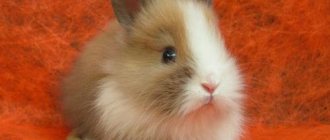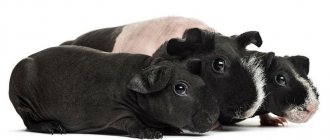How many years do decorative rabbits live?
People keep decorative animals at home for aesthetic pleasure. They have thicker and more beautiful fur than ordinary and wild ones. Weight remains virtually unchanged from birth.
Decorative rabbits are active, playful and not at all modest.
Decorative animals with erect ears live 7-8 years. Among them there are long-livers who live 10-12 years.
Long-lived rabbit records
Some decorative rabbits live 12 years. Judging by human standards, the age is quite decent. But there are known long-livers who managed to cross this line:
- Flopsy from Australia set an absolute record at the age of 18 years 10 months.
- Du, a New Jersey resident, died at age 17.
- Micah still lives in Illinois and is 16 years old.
Whether a rabbit will live to a ripe old age largely depends on the owners. A person cannot influence heredity, but creating comfort for a pet is a completely feasible task. Animals need tasty food, warmth, timely medical care and, of course, communication with their owner.
How long do dwarfs live?
Dwarf rabbits are a subtype of decorative rabbits. These are ideal pets to keep at home. They are easy to potty train and are highly trainable.
They are smart, impatient and inquisitive. Unlike other representatives, the Zaitsevs become attached to their owners, rejoicing when they come home. The owners walk the dwarf rabbits on a leash outside and leave them with friends.
Dwarf animals are placed in a small apartment. Their weight is 1.5 kilograms. The average life expectancy is from 5 to 7 years.
Lifespan of dwarf rabbits
Dwarf breeds include those species that weigh 1-1.3 kg. Dwarf rabbit breeds live on average 5-7 years. By nature, they are very playful, sociable and do not like to just sit in cages all day - they need regular activity.
Types of dwarf rabbits
In order for a dwarf rabbit to live as long as possible, certain rules must be followed.
- The animal should be physically active for at least an hour a day. This could be running in a wheel or around the apartment, playing with a person or something similar.
- Living conditions must be correct and food must be of high quality.
Interesting!
Rabbits are cute creatures that can live a very long time if given the right conditions.
- Vaccinations and timely treatment will help avoid the chance of contracting diseases or their aggravation.
- There should be calm all the time. Any stress for such animals can be dangerous.
Centenarians
Life expectancy directly depends on the care of your pet.
Wild rabbits died from the teeth of predators. The maximum lifespan is 3 years. You can extend the life of a wild rabbit at home. They love to fight with their relatives. If you prevent a rabbit from fighting, it will live twice as long as it should.
Decorative rabbits are pets. Life expectancy depends entirely on care. Neutered animals have priority and live longer. Females do not have to go through pregnancy and lactation.
Cases have been recorded when female dwarf rabbits lived for 10-12 years, and males lived for 15 years.
What determines the lifespan of rabbits?
There are a number of interrelated factors that affect how long these cute animals live. Among them are the following:
- heredity. One of the main factors influencing the life expectancy of a rabbit is its pedigree, i.e. genetic component. It is important that the breeding process is properly organized in the breeder’s estate or nursery. A responsible breeder separates pet families and monitors the purity of mating in order to obtain strong, viable offspring without developmental disabilities.
- immunity and breed diseases. The next important condition, the observance of which greatly depends on the quality and life of rabbits, is timely vaccination of animals and prevention of myxomatosis in combination with a viral hemorrhagic disease. Decorative rabbits are vaccinated with multifunctional vaccines. This is due to the fact that throughout their lives they are in direct contact with people. Vaccines protect animals from a range of diseases at once. Usually, one vaccine can protect pets from pasteurellosis, rabies, paraphyte and listeriosis.
Keeping rabbits
- care and timely care. Despite preventive measures, rabbits still remain very sensitive to any pathologies and can die even from a mild infection. Therefore, timely initiation of treatment is the first step to increasing the life of your pet. In case of any deviation from normal behavior, lethargic or abnormal condition of the animal, acute or mild symptoms, you should immediately contact a veterinarian, try to get specialist advice by phone or online and take initial measures. This moment has a particularly strong impact on how many years decorative rabbits live.
- microclimate. The quality of existence of the animal is significantly influenced by climatic conditions. Central heating radiators, air conditioners set to heat, and microwave ovens have a detrimental effect on the health and well-being of rabbits. In a room, barn, or any other room where an animal’s cage or pen is located, it is necessary to install a thermometer and monitor the temperature. For species that live outdoors, it is important to avoid excessive exposure to direct sunlight and frost. It is advisable to consult with the breeder from whom the pet was purchased regarding its usual conditions and temperatures.
- freedom of movement. Sufficient personal space is another important factor in extending the life of animals. The animal must be provided with the opportunity not only to move freely around the space of the pen, enclosure or cage, this space must be bright and well-equipped, since these animals are oppressed by excessive restrictions on area and activity. Decorative rabbits can be let out for a walk under supervision around the apartment, or even better - in the open air.
- psychological condition. Another important point is communication. Rabbits need company, not only from their owners, but also from their own kind or other friendly pets. According to statistics, animals that have contact with other animals live much longer. If the owners do not have the financial or housing opportunity to get another animal, they should take care to establish communication between the rabbit and other friendly animals from time to time.
What affects life expectancy?
Life expectancy depends on several reasons.
Genetics
When choosing, it is advisable to look at its pedigree, so it is better to contact professional animal breeding companies.
At birth, it is not clear what breed the baby rabbit is. Handling an animal is risky. Instead of an expensive decorative rabbit, a person can be sold a wild one, which will live only one year instead of the required seven years.
Conditions of detention
The rabbit must be provided with the best conditions. The first thing you need when moving into a house is a comfortable, spacious cage. Owners, when buying a cage for a small rabbit, choose the cage based on the size of the animal, not thinking that in the future it will be much larger.
It is important that he is not in the cage all the time. Once a day, he should be allowed to “walk” around the apartment for an hour. If possible, take the rabbit outside onto green grass. Do not give animals to children.
Rabbits are fragile mammals and are easily damaged by mechanical damage. The sharp sound can even cause their heart to stop.
Lazy owners are doomed to have an unhealthy and lethargic pet. Every day the animal needs to clean the cage of droppings and change the sawdust.
It is important to keep the water clean. You cannot place the cage next to an open window. Decorative animals get sick easily. Placing the cage near the scorching sun is also unwise. Overheating is dangerous for all Zaitsev representatives.
If the rabbit has become lethargic and its eyes are cloudy, then an urgent visit to the veterinarian is required.
Nutrition
Proper nutrition is the key to a long life. Decorative rabbits require a balanced diet with the right amount of calories and nutrients.
For a rabbit, as for a person, gaining weight is dangerous. Excessive nutrition is harmful to the animal; problems with the cardiovascular system and reproductive function may appear.
The diet should be dominated by herbs and grains. If the animal weighs too little, you can add food.
Care and maintenance rules for a full life
Simple practical care tips will contribute to the full and long life of your pet:
- Physical activity is the most important criterion for a rabbit's long life. A sedentary lifestyle contributes to obesity, the development of cardiovascular diseases and gastrointestinal problems. Every day the rabbit should walk outside the cage for at least an hour, preferably in the fresh air. The cage should be equipped with toys for active activities - balls, ladders, spruce or pine cones, tunnels.
- Appropriate place. A cage with a decorative pet should be placed in a place where there are no drafts or dampness; it should not be placed under the scorching rays of the sun or next to heating devices. In addition, it should not be placed near “noisy” equipment - televisions, music centers with speakers. The cage should be spacious so that the rabbit can easily stand there at full height on its hind legs. It is advisable to equip a house in it for the pet’s privacy. It is also desirable to have a sandbox where he can dig around and hide something.
- Provide good climatic conditions. Eared animals do not tolerate heat, stuffiness and high humidity. Dampness and high carbon dioxide content are unacceptable for them. Ventilate the room as often as possible, preventing drafts from reaching your pet. The optimal temperature is 18–20 degrees.
- Water procedures. Washing animals is not recommended; it is allowed only in cases of extreme necessity. The washing procedure should take place in a warm room, in warm water. The pet is immediately wrapped in cloth until the fur is completely dry.
- Safety . Do not leave your rabbit unattended while walking, either indoors or outdoors. Do not push, kick or throw him under any circumstances. Grabbing a rabbit by the ears and skin is deadly.
- Prevention of diseases. Directly strengthening the immune system with special vitamin supplements (rabbits need vitamins B12, A, E, D), as well as vaccination. Mandatory vaccination of rabbits according to plan can significantly reduce the likelihood of developing infectious diseases. Any suspicious symptom in a rabbit’s behavior should not be ignored.
- Balanced diet. Don't overfeed or starve. Feed should always be fresh and water clean. Food must be only healthy and approved for rabbits.
- Cleaning the cage. The cage must be cleaned regularly, the feeder and drinking bowl must be washed. Do not allow water to stagnate and food to rot in the bowl. The tray is cleaned daily!
- There must be branches in the cages (apple trees, pear trees, linden trees, birch trees).
Interesting facts about rabbits
- They are excellent jumpers. They jump onto objects up to three meters high.
- They live in groups, unlike hares, which prefer solitude.
- False pregnancy happens.
- They multiply quickly due to the double uterus of the rabbit. She can bear several fetuses, started at different times.
- One long-lived rabbit lived 19 years.
- Animals only sweat on their paw pads.
- They can die of fear (literally).
- Number of teeth – 28.
- During the Middle Ages, people released them onto uninhabited islands so that shipwrecked people would have something to eat.
- Hares run faster than rabbits.
- They see what is happening from behind without turning their heads.
- Scientists have calculated that if they are allowed to reproduce, the number of rabbits will be equal to the number of square meters on earth in ninety years.
- They have 1700 taste buds.
Signs of old age
While vaccination helps an eared dog avoid illness, a universal antidote for old age has not yet been invented. Unfortunately, just like people, rabbits age. The following signs signal the onset of old age:
- decreased playfulness and physical activity;
- blurred eyes;
- hair thinning not associated with shedding;
- decreased appetite;
- saggy belly.
It is worth remembering that these signs can be symptoms of a disease, and not just old age. If you do not have much experience in rabbit breeding, it is better to consult a veterinarian on this issue. He will indicate exactly what is causing the animal’s unusual condition – old age or disease.
Bunnies for fluff
On average, downy bunnies live approximately 5-7 years. During this time, they manage to cut up to 40 kg of fluff from one individual. And although the indicators are quite high, natural rabbit fur is becoming less in demand.
Among the downy animals there are also long-livers. The Angora rabbit is capable of living up to the 10 year mark; down production is greatly reduced. If you provide the animal with ideal conditions, then this figure can be 12 years.
Animals do not live to such an age, as soon as the productivity of the eared animal drops, it is immediately slaughtered for meat, which is not inferior in quality to meat animals.
The second prominent representative among the “fur coat” animals is the Arctic fox rabbit. Their life cycle is 12 years, although there are exceptions when the animal lives up to 15. These figures are quite high for rabbits, but these are only a few representatives with which the white fluffy rabbit can compete. And although its maximum is 10 years, there are still 13-year-old representatives.
Interesting fact! Giant rabbits raised at home in a cage can live up to 20 years. The fact is that due to their large size and low mobility, the metabolic process slows down, which reduces the load on the heart. Decorative rabbits, on the contrary, have the shortest life cycle.
As you can already see, a meat rabbit can live 1 year longer than a fur rabbit. These are theoretical figures; a down rabbit can survive a meat rabbit without any problems, it all depends on the content and nutrition.
Signs of aging
To determine the onset of aging in rabbits, it is necessary, first of all, to pay attention to the behavior and appearance of the animal. The following factors will help determine this:
- the wool becomes thinner, and this is not related to the time of year;
- appetite disappears, the pet does not react to its favorite food with the same joy;
- physical activity decreases, the rabbit becomes lethargic;
- there is no sparkle in the eyes;
- the skin on the belly sags, this is especially noticeable in females.
These are the first signs of old age, but at the same time they can indicate illness, especially if the pet has recently arrived in the house. If symptoms are detected, you should visit a veterinarian.
In wild nature
Rabbits living in natural conditions do not have longevity. There are more than 47 varieties of wild rabbit breeds, their lifespan is no more than 1.5-3 years. This is due to a large number of natural enemies, various diseases, and lack of regular and balanced food.
The greatest threat to rabbits comes from other animals and birds, for which they become a source of meat. Only 50% of young individuals manage to escape from predators, while the rest die.
Dwarf breeds
Dwarf rabbit breeds are long-lived. A representative of miniature species lives noticeably longer than its large-sized “brother”. The average lifespan of dwarf species is 8-11 years.
IMPORTANT! With a properly formulated diet, lack of stress, necessary physical activity and daily walks in the fresh air, a dwarf pet can delight a family for up to 13-14 years.
Fold breeds
Fold-eared breeds are distinguished by their small, compact size, calm, balanced character. These animals quickly adapt to living in a city apartment or private house; they love to spend time with their owner and play with children.
Friendliness and the ability to live in harmony with the environment help lop-eared rabbits delight their owners with 7-9 years of pleasant emotions and positivity.
Average life expectancy
The average life expectancy of a rabbit living in the wild usually does not exceed 1.5-4 years. Ordinary, wild breeds are constantly attacked by natural enemies; they are forced to look for food every day. These factors significantly shorten the animal's lifespan.
IMPORTANT! The only exception is rabbits living in Australia. In this region, the animal has no natural enemies, which allows it to live up to 11-13 years.
Domestic rabbits of meat breeds are slaughtered at the age of 6-7 months, broiler species - up to six months. Rabbit breeders know that if they are not slaughtered, they live up to 5-8 years, castrated individuals - up to 12 years of age.
How to extend the life of a pet
Owners can extend a rabbit's lifespan if they follow the rules of care. Quality care includes not only the organization of food and living conditions, but also care for the mental state of pets.
Keeping it clean
It is important for your pet to have a separate place where he returns to sleep, or where food and drink await him. Domestic rabbits are usually kept in cages. The surface of the cage, drinking bowl and food compartment must be cleaned daily. It is recommended to disinfect all items weekly using suitable antiseptic agents.
Nutrition
The diet is prepared in advance, taking into account the characteristics of a particular rabbit. Young individuals receive a variety of food, taking into account the fact that they need to gain weight. Separately organize the nutrition of females with offspring or aging rabbits, which gradually begin to lose their appetite.
The menu should contain the following items:
- dry cereal feed: oats and barley;
- fresh root vegetables;
- compound feed;
- grass or hay;
- vitamins and minerals.
The drinking bowl is filled with fresh drinking water. If necessary, medications for the pet are added to it.
Conditions of detention
The most common option for keeping rabbits is cage placement. As a rule, they are designed for one pet, although in the summer two adult individuals are housed outdoors in one block, provided there are no conflicts between them.
See also
What can you feed rabbits in winter at home, rules for beginnersRead
The cell consists of two combined blocks. One of them is intended for sleeping; there is bedding there. The other contains a feeder, water bowl and toilet. The cages are positioned so that the animals do not overheat or become hypothermic. This provokes diseases to which animals are susceptible.
Keeping in enclosures or pits is a separate organization of the life of pets. In each case, it is necessary to take into account the air temperature and humidity. Aviary housing is especially common in warm regions, when owners do not need to worry about moving their pets for the winter.
Reference! Maintenance using dug holes is associated with the need to comply with the placement conditions. The place for the pit should be far from groundwater or wetlands so that the humidity level is comfortable for the animals.
Safety
Rabbit cages or mini-farms are usually located a short distance from the ground. This is due to the fact that rabbits are often attacked by rodents or insects. They are carriers of infection, so special attention is paid to the safety of rabbits.
Barns or outbuildings where units with animals are housed are regularly treated with protective agents to prevent pest attacks.
Protection from stressful situations
Mental health for a rabbit is no less important than physical health. Rabbits need their relatives nearby. That is why supporters of aviary keeping are against the construction of individual cages.
Breeders claim that cage housing helps maintain hygiene and control the amount of food consumed, but at the same time, pets really need dosed communication with representatives of a related breed.
Constant suppression of the rabbit's desires has a negative impact on the mental state. Restriction in space provokes stress, loss of appetite, and depression, so when planning conditions, it is necessary to remember that animals need walks in nature, even if they are limited by protective nets.











